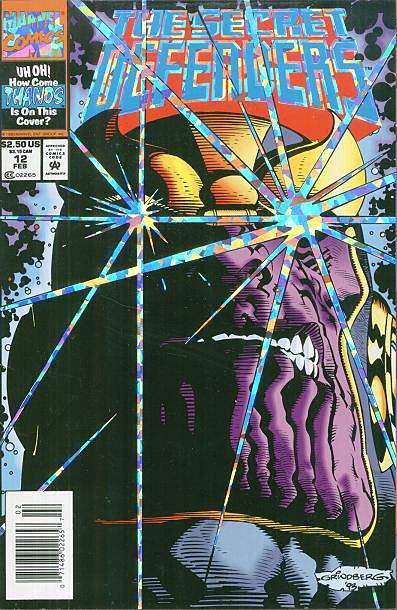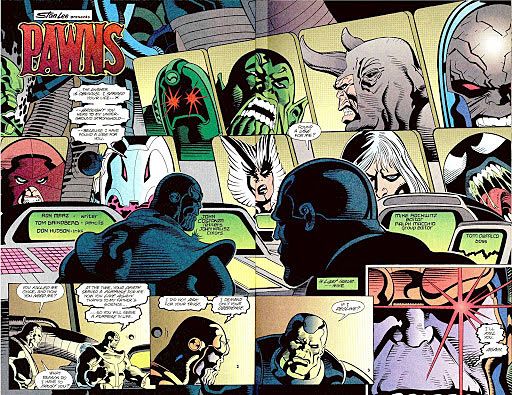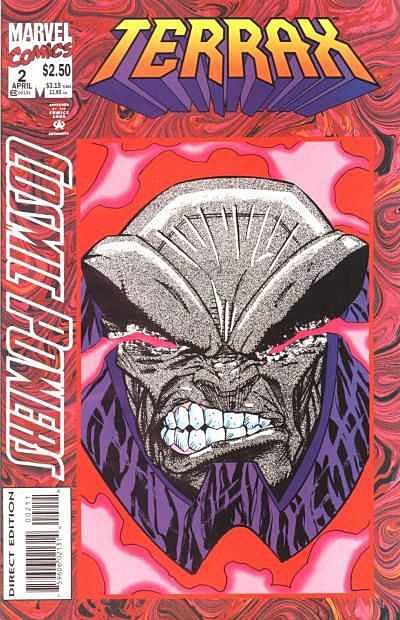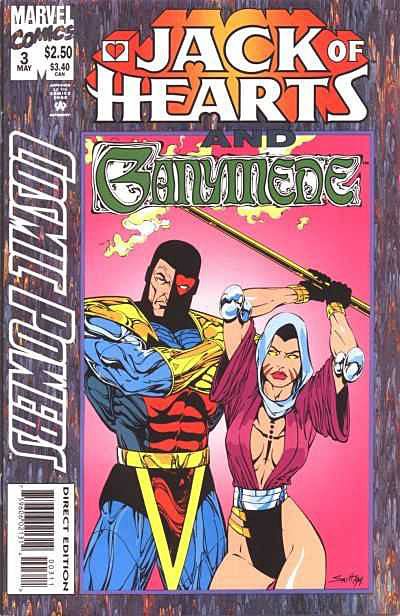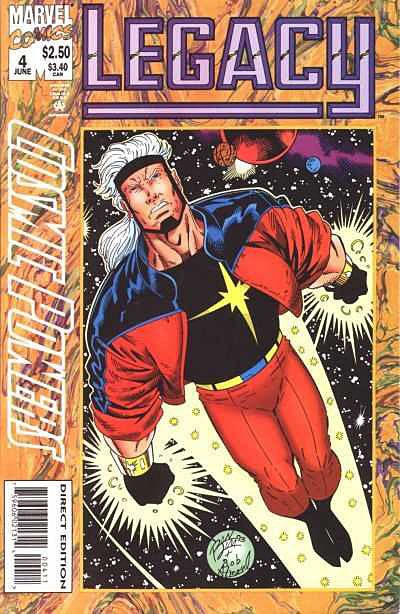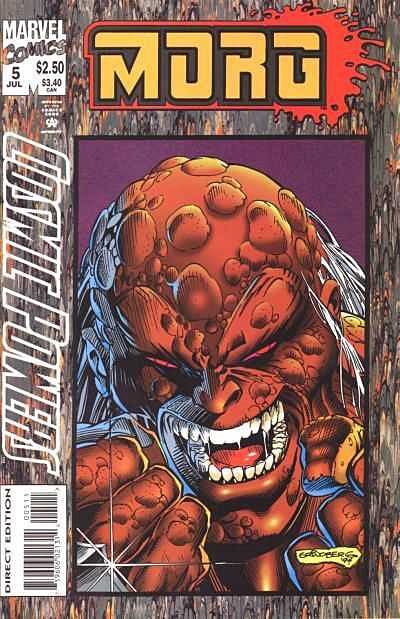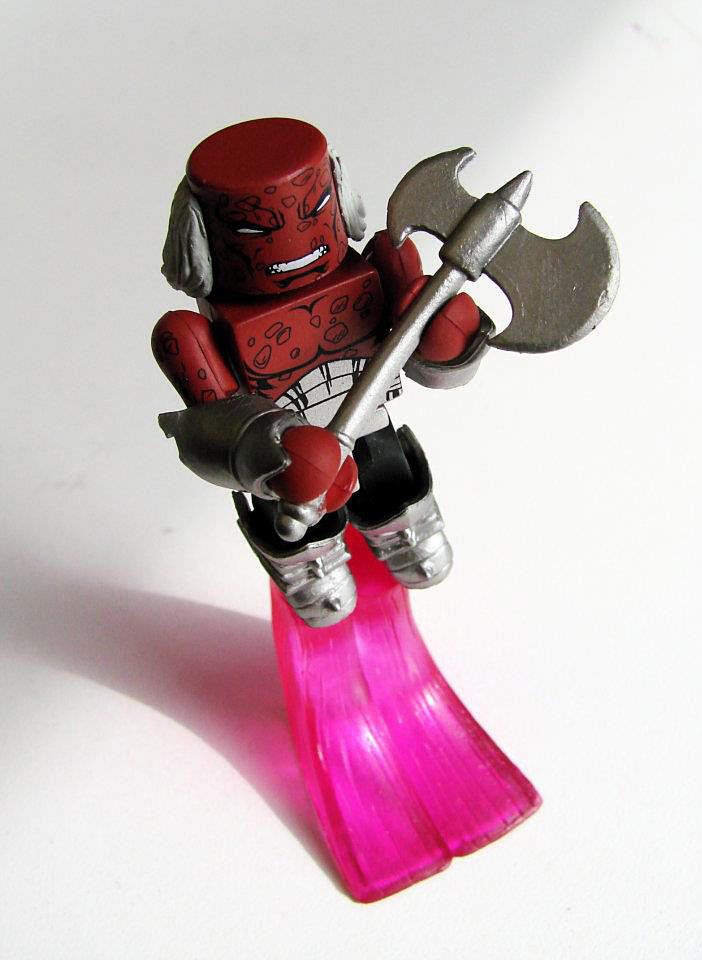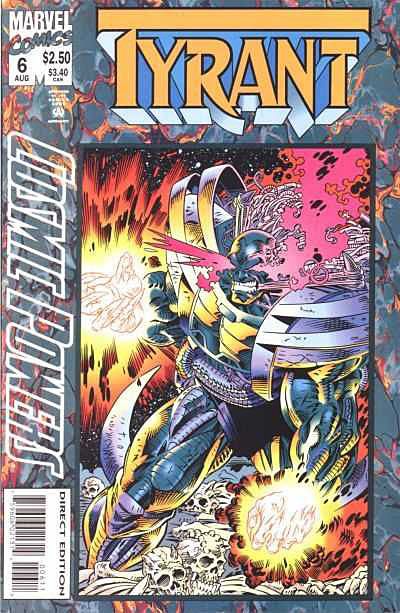I hardly ever go back and read my own stories. Part of it is... well, I already know how they all end, and I have a lot of other things to read. But more than that, I'd always rather look forward than back. I want to spend time on the next story, not one that's already in the rear-view mirror.
I think almost any creator -- be it writer or artist -- tends to concentrate on the flaws when looking back at their work. You apply what you've learned since then, and the things you could've done better are the ones that jump out at you, the ones you fixate upon. But you can't change any of it, you can only try to make the next gig better.
Not long ago, the FedEx truck showed up in my driveway and dropped an envelope from Marvel on my front steps. Inside, one copy of the new "Thanos: Comic Powers" trade paperback. The book collects the "Cosmic Powers" six-issue miniseries I wrote in 1994, and three issues of "Secret Defenders" starring Thanos, also from 1994. Obviously, interest (and sales) in all things Thanos, thanks to his past and upcoming cinematic appearances, spurred this collection's existence.
I hadn't looked at any of these issues, except for signing the covers at conventions, in years. So for once I didn't simply toss the comp copy on the pile and get back to work. Instead, I sat down in the Stickley armchair in my office and perused the collection of stories I wrote more than two decades ago.
The "Secret Defenders" assignment was one I never expected (or wanted). I recounted the story of how it landed in my lap in a column from a few years ago. These issues were the result of storylines I made up on the spot during a Marvel lunch meeting.
The underlying concept of the "Secret Defenders" series was akin to the television incarnation of "Mission: Impossible," with Doctor Strange selecting teams of various heroes to undertake specific missions. For the issues reprinted in this volume, I replaced the good Doctor with Thanos, and the heroes with villains. Thankfully, it was a time in comics when you could just pick a handful of characters you were interested in using and, within reason, be allowed to do what you wanted to do. I chose Nitro, Rhino, Titanium Man and Super Skrull.
Nitro: because I remembered him from "Captain Marvel" issues I picked off the spinner rack as a kid. Rhino: because I had fun writing him in "Silver Surfer" #54 (where his inclusion was inspired by an episode of the '60s "Spider-Man" cartoon). Titanium Man: because I remembered him from the cover of a Silver Age "Tales of Suspense" issue I found in our basement as a kid. Super Skrull: because he's a Skrull. And super.
In all honesty, the best thing in my entire "Secret Defenders" run was probably the cover to issue #12 by Tom Grindberg, which featured a moody, shadow-drenched headshot of Thanos with glowing, silver foil eyes. The excess of the '90s yielded a lot of terrible covers bedecked with foil and chromium and holograms. But I loved the "Secret Defenders" #12 cover then, and I still love it now.
The story itself? Well, I guess the best thing I can say is I'm still happy with how I wrote Thanos. The Mad Titan does what he does, using the villains to get what he wanted. I enjoyed every time I wrote Thanos, the "Secret Defenders" issues were no exception.
One other note: issue #12 included a glimpse of Darkseid on one of the monitors Thanos views when he selects his team. Yes, it's something I asked for in the script, and yes, the editor knew about it and let it go with a wink. It was a different time, with different regimes at Marvel and DC. Now, when these properties are part of billion-dollar franchises, the corporate cultures would never let something like that slip through.
The remainder of the collection is the "Cosmic Powers" series, each of the six double-sized issues featuring a different character from the cosmic pantheon. Of course, the real star is Thanos, engaged in another plot to obtain ultimate power, and using others as his pawns.
The project was conceived when the comic market was booming in the '90s, and Marvel was scrambling to push out as much product as possible. My memory is a little hazy on the specifics, but I believe the project was conceived by editorial as six double-size issues, and I was given free rein to come up with the format beyond that.
I remember the editor, Craig Anderson (son of Marmaduke creator Bard Anderson) showing me samples of the patterned paper that served as border devices on the covers. I thought they were kind of ugly, but at that time, every cover gimmick was being trotted out.
The story was constructed so that a different art team could handle each issue, the thinking being that we wouldn't be able to find a team that could handle six double-size issues (more than 200 pages) in the time available. The episodic storyline focused on specific characters in each respective issue, including a number I had created in my concurrent "Silver Surfer" run: Morg, a new herald for Galactus; Ganymede, a warrior monk; Legacy, the son of Captain Marvel; and Tyrant, a universe-conquering villain worthy of Thanos.
I was still learning my way as a writer on these issues. The first comic script I ever wrote, and I do mean ever, was printed as an issue of "Silver Surfer." It was all on-the-job training for me. Here's what jumped out at me looking back at the "Cosmic Powers" issues.
Issue #1, "Thanos": Our lead-in issue was drawn by the master of most things cosmic in the era, Ron Lim. Ron was the first artist I ever worked with, thanks to me cutting my teeth on "Silver Surfer," and he was Jim Starlin's partner on all the "Infinity" projects. Ron was a fast artist, but even so, I was (and still am) amazed at how much material Ron drew in this period. I'm guessing he managed to squeeze in these pages because he was between "Infinity" series... and because that Ron liked drawing Thanos as much as this Ron liked writing him.
The issue opens with a lengthy silent passage, introducing Thanos on a vast, corpse-strewn battlefield, and immediately kicking off an action sequence as Thanos slays a final opponent. The coup de grace delivered, Thanos boards his ship Demeter, the name taken from the craft that brings Dracula to England.
I'm faintly embarrassed at the presence of sideways spreads throughout the series, the first one showing up in the Thanos opening sequence. It's something I would never do again, but it was all the rage for a few years.
The thing that pleases me the most about my work here is the attention to craft, taking the time to introduce characters, concepts and backstory. That's something I learned from Starlin, making sure the reader has all the necessary information to grasp context, presented as part of the story rather than an awkward information download.
I hadn't remembered that each issue starts with a quote: Francis Bacon, Jean Renoir, George Saville, Paul Fleming, Lewis Carroll, Sir William Jones. I must have given "Bartlett's Familiar Quotations" a workout. This issue's, by Bacon, seems especially apt for Thanos: "Knowledge itself is power."
Issue #2, "Terrax": We had initially discussed Ron Lim trying to draw the entire series, but he was pulled in so many different directions, on so many different projects, that it was impossible. So the artist tabbed for the issue starring former Galactus herald Terrax was Jeff Moore, someone the editor had been wanting to try out.
I'm pretty certain this was the only time I ever worked with Jeff Moore, and I have no idea whatever happened to him. As far as I can tell, he hasn't had a comic credit in two decades. The overly-stylized art wasn't really to my taste, and I feel like it's the weakest issue of the six.
The issue starts with a sideways spread, followed by a sideways splash. Oh, the shame. Looking at Tom Vincent's color, I have to wonder if we were running tight on deadline. It's old-school flat color, via color guides, before the advent of computer coloring. But even so, the back half of the issue has entire backgrounds and crowd scenes knocked out in flat monochromatic color that screams, "We're late!"
Issue #3, "Jack of Hearts and Ganymede": Opens with another sideways spread. Yikes.
One of the poor decisions early in my career was my suggestion that Jack of Hearts needed a simplified costume. Maybe artists appreciated taking out all that detail, but the revised costume was never as good as the original. When you start in the business and you're playing with other people's toys, you often think you know better. Most of the time, you don't.
My friend Andy Smith handled the pencil art on this issue, with Bill Anderson inking. One of the fundamental changes in comics from this era to now is the almost wholesale disappearance of inkers as separate entities. With a few exceptions, artists who only ink are going the way of the buggy whip. All these years later, I see Bill at every Albany Comic Con, and Andy are I are still close friends. This was the second time Andy and I worked together, after doing a fill-in issue of Quasar that eventually saw print as #59. Andy gave me the issue-closing splash teasing Legacy for the following issue.
I still have a soft spot for the "holy warrior" Ganymede, even though nothing much came of the character. Maybe that's part of the reason why I was drawn to Top Cow's Magdalena later in my career.
Issue #4, "Legacy": Ron Lim returned for Legacy, whom we created as part of Marvel's 1993 initiative of new characters introduced (with trading card!) in shrink-wrapped Annuals.
Our intention was to simply refer to Mar-Vell's son Genis as Captain Marvel. But our request was turned down repeatedly because, we were told, Marvel already had a Captain Marvel in Monica Rambeau. So we settled on the named Legacy. Eventually, of course, Genis became Captain Marvel and had his own series for a while, with a much better costume, but I was never afforded the opportunity to write him in that period.
I have no real defense for Legacy's rolled-up-sleeves jacket and ponytail. What can I say? It was the '90s. But the story itself seemed like a natural one to tell, with Legacy hunting down Nitro for his part in his father's death. Most artists start out by imitating their heroes. Writers are no different, and I was walking in Jim Starlin's footsteps here.
Issue #5, "Morg": I think this is where I started to learn something about creative casting. Tom Grindberg, with his Frazetta-influenced art, was a great fit for this issue featuring the axe-wielding Morg, a barbaric executioner who became herald of Galactus. The imagery during the flashback to Morg's homeworld would fit comfortably into a Conan story.
Morg is certainly not the most popular character I've created. I guess that distinction still goes to Kyle Rayner. But Morg did get his own MiniMate, which occupies a place on my office shelf.
The threads of the story start to intertwine here, as the machinations of Thanos bring together all the players. I have to admit to getting a grin looking back at Morg and Terrax going axe to axe.
Issue #6, "Tyrant": Terrific artwork on the finale by Scot Eaton, who would eventually join the CrossGen studio in Florida (as would Andy Smith). Thanos lets his dupes battle Tyrant while he obtains the arcane object of his desire, and then we get the Thanos vs. Tyrant slobberknocker that this was always leading to.
Thanos escapes with his prize, but it turns out to be a hollow victory, like so many of his efforts. As Thanos says, "I have learned through bitter experience that power is a means to an end, not an end in itself." Both here and in the opening issue, I loved writing the first-person narration for Thanos. His voice came to me easily. Not sure what that says about me, that I found the voice of a mass-murdering, cosmic nihilist so easy to grasp. Thanos is among my favorite characters ever to write; certainly my favorite villain, in a universe filled the great villains.
At the back of the collection, there's a reprinted interview with me from "Marvel Age" #133, released prior to the original debut of "Cosmic Powers." It's a little odd reading an interview with yourself from more than two decades ago, including a picture of me in my early 20s. It's as close to a time machine as I'll ever get.
I know I'm a better writer now than I was back then, though there's a youthful exuberance to the "Cosmic Powers" stuff that I can take some pride in. I see hints of where I was going. Enthusiasm is a valuable commodity. But it doesn't outweigh experience and craft.
Ron Marz has been writing comics for two decades, and thinks it's pretty much the best job ever. His current work includes "Witchblade" and the graphic novel series "Ravine" for Top Cow, "The Protectors" for Athleta Comics, his creator-owned title, "Shinku," for Image, and Sunday-style strips "The Mucker" and "Korak" for Edgar Rice Burroughs, Inc. Follow him on Twitter (@ronmarz) and his website, www.ronmarz.com.


